Bilingual Education in Australia Elaborated by: Ionaşcu Mihaela

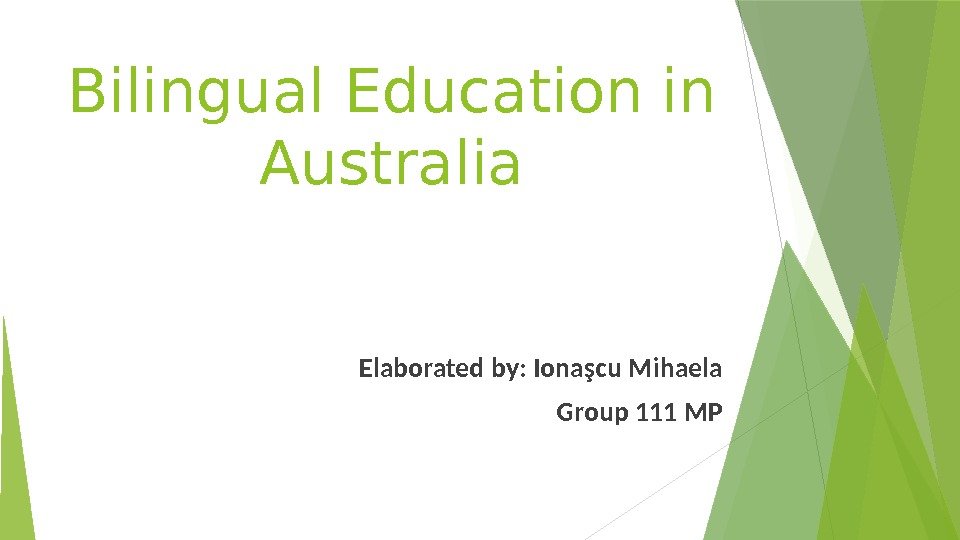

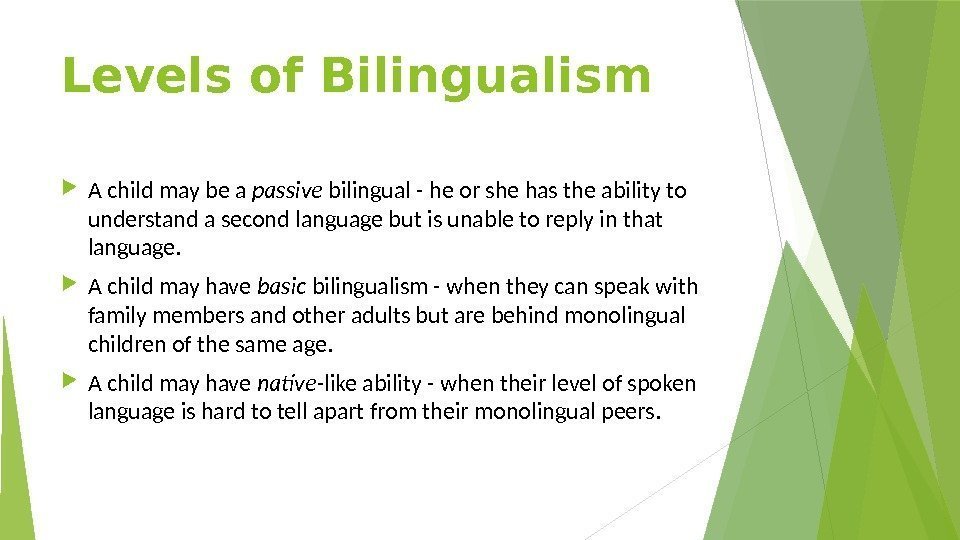
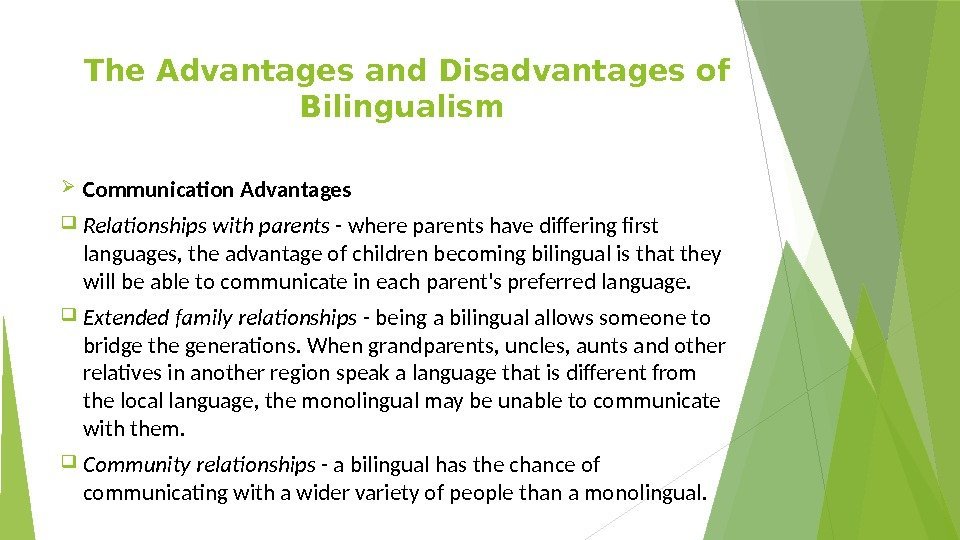
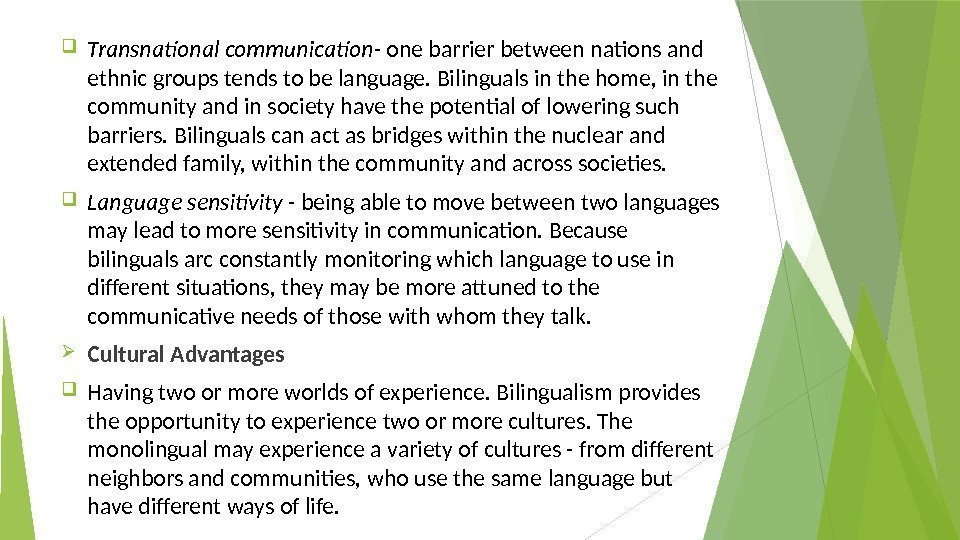
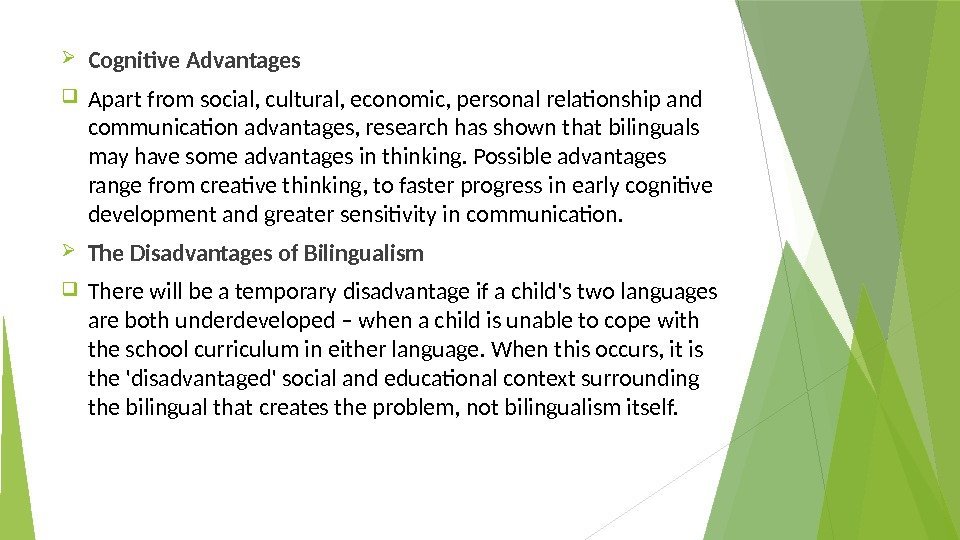
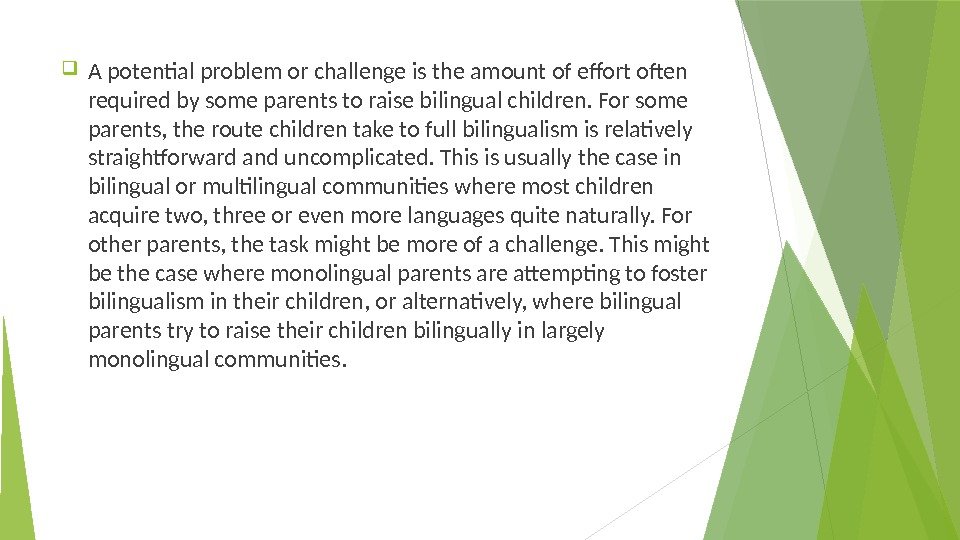
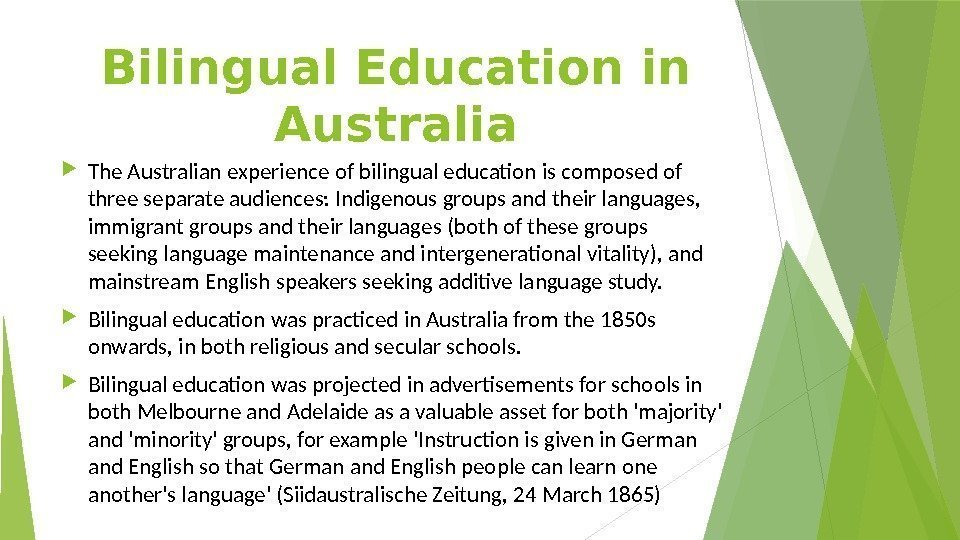
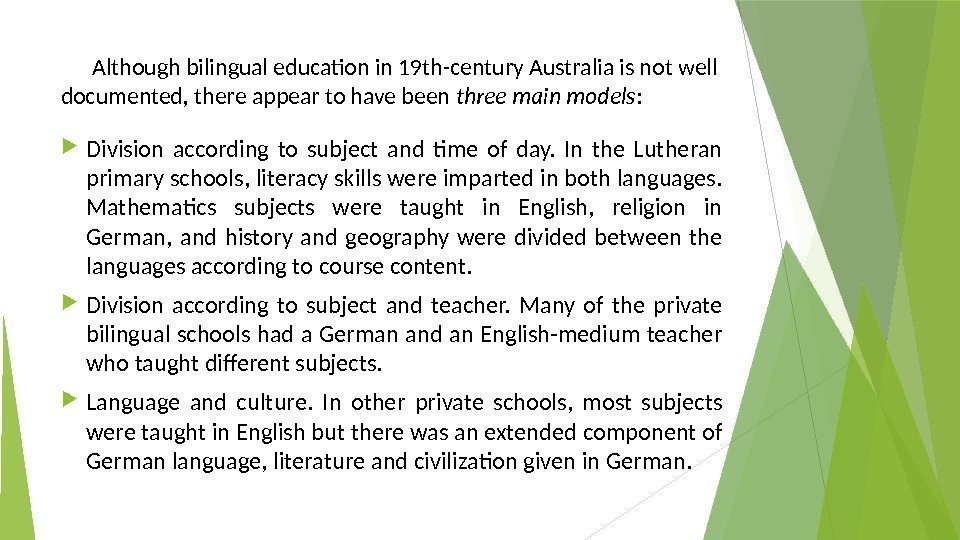
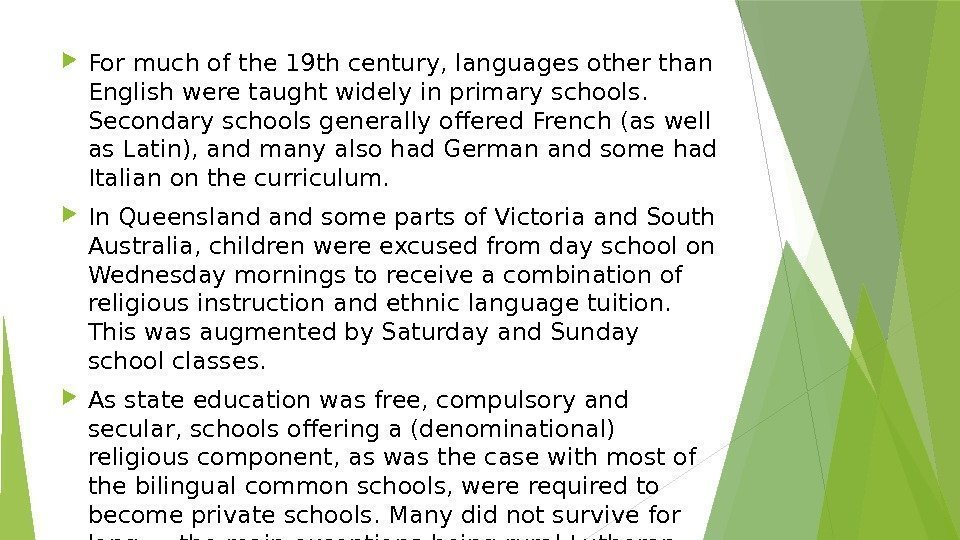
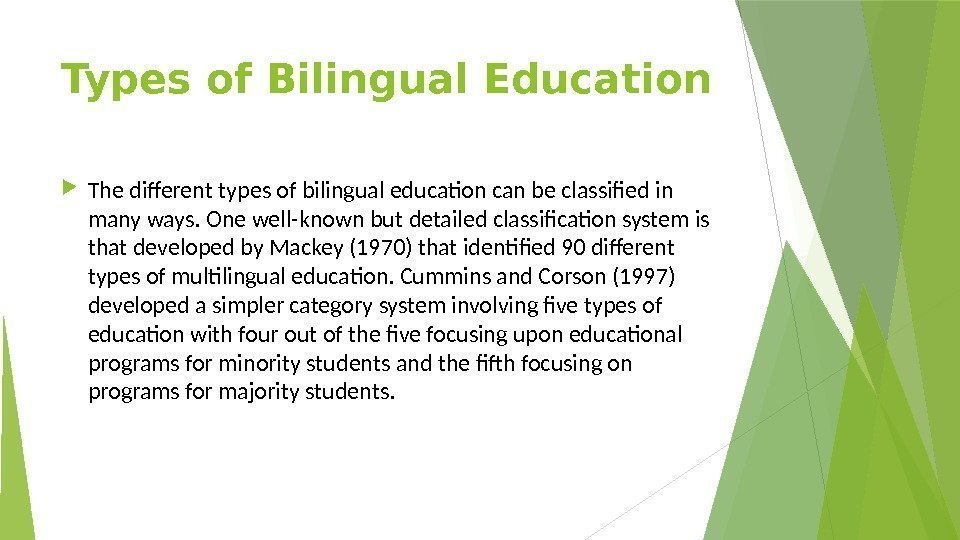
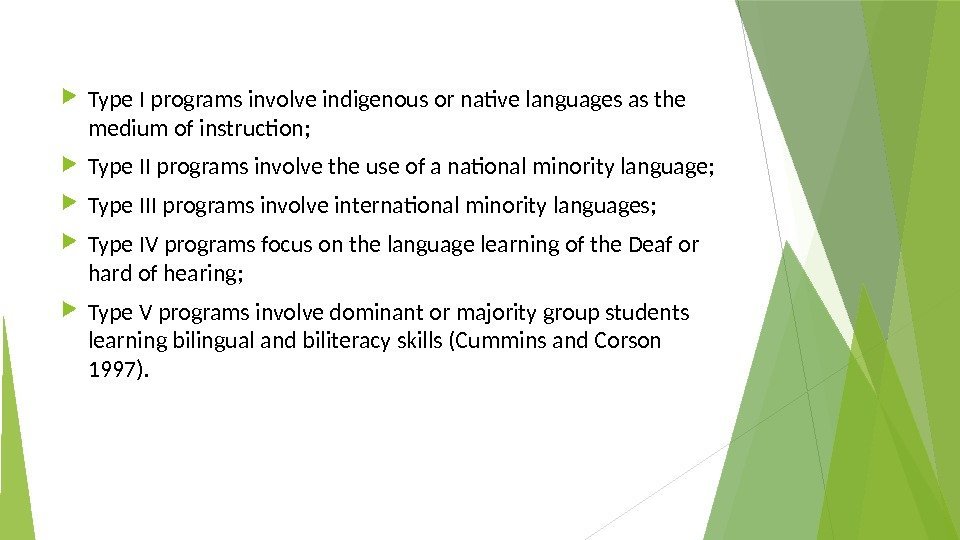
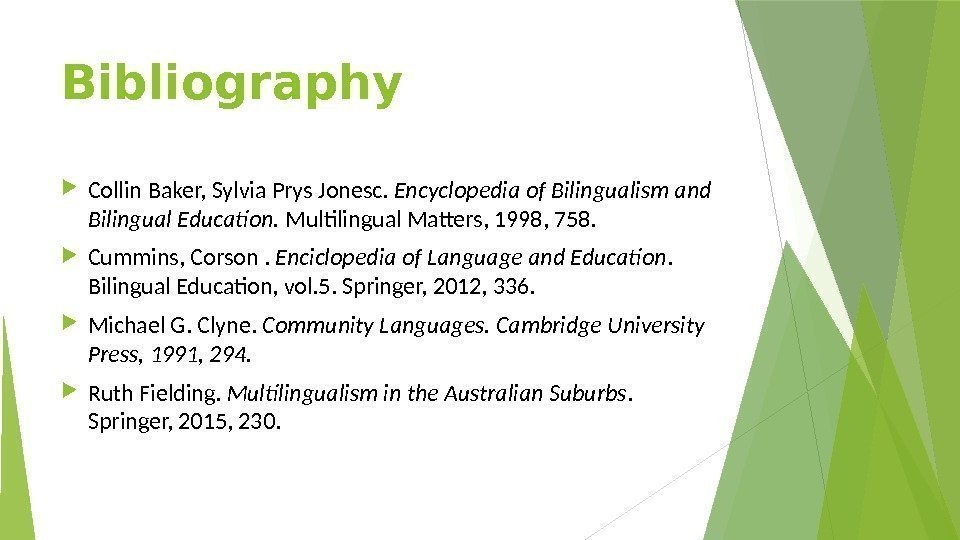
bilingual_education_in_australia.pptx
- Размер: 65.7 Кб
- Автор:
- Количество слайдов: 13
Описание презентации Bilingual Education in Australia Elaborated by: Ionaşcu Mihaela по слайдам
 Bilingual Education in Australia Elaborated by: Ionaşcu Mihaela Group 111 MP
Bilingual Education in Australia Elaborated by: Ionaşcu Mihaela Group 111 MP
 The definition of bilingualism The term bilingual refers to two or more languages, and therefore represents the multilingual experiences of children as well as those who have only two languages (Grosjean 1982; Romaine 1995). Li (2006) gives one definition of bilingualism as «a product of extensive language contact (i. e. , contacts between people who speak different languages)», indicating that a large quantity of contact with both languages is required before a person can be considered bilingual.
The definition of bilingualism The term bilingual refers to two or more languages, and therefore represents the multilingual experiences of children as well as those who have only two languages (Grosjean 1982; Romaine 1995). Li (2006) gives one definition of bilingualism as «a product of extensive language contact (i. e. , contacts between people who speak different languages)», indicating that a large quantity of contact with both languages is required before a person can be considered bilingual.
 Levels of Bilingualism A child may be a passive bilingual — he or she has the ability to understand a second language but is unable to reply in that language. A child may have basic bilingualism — when they can speak with family members and other adults but are behind monolingual children of the same age. A child may have native -like ability — when their level of spoken language is hard to tell apart from their monolingual peers.
Levels of Bilingualism A child may be a passive bilingual — he or she has the ability to understand a second language but is unable to reply in that language. A child may have basic bilingualism — when they can speak with family members and other adults but are behind monolingual children of the same age. A child may have native -like ability — when their level of spoken language is hard to tell apart from their monolingual peers.
 The Advantages and Disadvantages of Bilingualism Communication Advantages Relationships with parents — where parents have differing first languages, the advantage of children becoming bilingual is that they will be able to communicate in each parent’s preferred language. Extended family relationships — being a bilingual allows someone to bridge the generations. When grandparents, uncles, aunts and other relatives in another region speak a language that is different from the local language, the monolingual may be unable to communicate with them. Community relationships — a bilingual has the chance of communicating with a wider variety of people than a monolingual.
The Advantages and Disadvantages of Bilingualism Communication Advantages Relationships with parents — where parents have differing first languages, the advantage of children becoming bilingual is that they will be able to communicate in each parent’s preferred language. Extended family relationships — being a bilingual allows someone to bridge the generations. When grandparents, uncles, aunts and other relatives in another region speak a language that is different from the local language, the monolingual may be unable to communicate with them. Community relationships — a bilingual has the chance of communicating with a wider variety of people than a monolingual.
 Transnational communication — one barrier between nations and ethnic groups tends to be language. Bilinguals in the home, in the community and in society have the potential of lowering such barriers. Bilinguals can act as bridges within the nuclear and extended family, within the community and across societies. Language sensitivity — being able to move between two languages may lead to more sensitivity in communication. Because bilinguals arc constantly monitoring which language to use in different situations, they may be more attuned to the communicative needs of those with whom they talk. Cultural Advantages Having two or more worlds of experience. Bilingualism provides the opportunity to experience two or more cultures. The monolingual may experience a variety of cultures — from different neighbors and communities, who use the same language but have different ways of life.
Transnational communication — one barrier between nations and ethnic groups tends to be language. Bilinguals in the home, in the community and in society have the potential of lowering such barriers. Bilinguals can act as bridges within the nuclear and extended family, within the community and across societies. Language sensitivity — being able to move between two languages may lead to more sensitivity in communication. Because bilinguals arc constantly monitoring which language to use in different situations, they may be more attuned to the communicative needs of those with whom they talk. Cultural Advantages Having two or more worlds of experience. Bilingualism provides the opportunity to experience two or more cultures. The monolingual may experience a variety of cultures — from different neighbors and communities, who use the same language but have different ways of life.
 Cognitive Advantages Apart from social, cultural, economic, personal relationship and communication advantages, research has shown that bilinguals may have some advantages in thinking. Possible advantages range from creative thinking, to faster progress in early cognitive development and greater sensitivity in communication. The Disadvantages of Bilingualism There will be a temporary disadvantage if a child’s two languages are both underdeveloped – when a child is unable to cope with the school curriculum in either language. When this occurs, it is the ‘disadvantaged’ social and educational context surrounding the bilingual that creates the problem, not bilingualism itself.
Cognitive Advantages Apart from social, cultural, economic, personal relationship and communication advantages, research has shown that bilinguals may have some advantages in thinking. Possible advantages range from creative thinking, to faster progress in early cognitive development and greater sensitivity in communication. The Disadvantages of Bilingualism There will be a temporary disadvantage if a child’s two languages are both underdeveloped – when a child is unable to cope with the school curriculum in either language. When this occurs, it is the ‘disadvantaged’ social and educational context surrounding the bilingual that creates the problem, not bilingualism itself.
 A potential problem or challenge is the amount of effort often required by some parents to raise bilingual children. For some parents, the route children take to full bilingualism is relatively straightforward and uncomplicated. This is usually the case in bilingual or multilingual communities where most children acquire two, three or even more languages quite naturally. For other parents, the task might be more of a challenge. This might be the case where monolingual parents are attempting to foster bilingualism in their children, or alternatively, where bilingual parents try to raise their children bilingually in largely monolingual communities.
A potential problem or challenge is the amount of effort often required by some parents to raise bilingual children. For some parents, the route children take to full bilingualism is relatively straightforward and uncomplicated. This is usually the case in bilingual or multilingual communities where most children acquire two, three or even more languages quite naturally. For other parents, the task might be more of a challenge. This might be the case where monolingual parents are attempting to foster bilingualism in their children, or alternatively, where bilingual parents try to raise their children bilingually in largely monolingual communities.
 Bilingual Education in Australia The Australian experience of bilingual education is composed of three separate audiences: Indigenous groups and their languages, immigrant groups and their languages (both of these groups seeking language maintenance and intergenerational vitality), and mainstream English speakers seeking additive language study. Bilingual education was practiced in Australia from the 1850 s onwards, in both religious and secular schools. Bilingual education was projected in advertisements for schools in both Melbourne and Adelaide as a valuable asset for both ‘majority’ and ‘minority’ groups, for example ‘Instruction is given in German and English so that German and English people can learn one another’s language’ (Siidaustralische Zeitung, 24 March 1865)
Bilingual Education in Australia The Australian experience of bilingual education is composed of three separate audiences: Indigenous groups and their languages, immigrant groups and their languages (both of these groups seeking language maintenance and intergenerational vitality), and mainstream English speakers seeking additive language study. Bilingual education was practiced in Australia from the 1850 s onwards, in both religious and secular schools. Bilingual education was projected in advertisements for schools in both Melbourne and Adelaide as a valuable asset for both ‘majority’ and ‘minority’ groups, for example ‘Instruction is given in German and English so that German and English people can learn one another’s language’ (Siidaustralische Zeitung, 24 March 1865)
 Although bilingual education in 19 th-century Australia is not well documented, there appear to have been three main models : Division according to subject and time of day. In the Lutheran primary schools, literacy skills were imparted in both languages. Mathematics subjects were taught in English, religion in German, and history and geography were divided between the languages according to course content. Division according to subject and teacher. Many of the private bilingual schools had a German and an English-medium teacher who taught different subjects. Language and culture. In other private schools, most subjects were taught in English but there was an extended component of German language, literature and civilization given in German.
Although bilingual education in 19 th-century Australia is not well documented, there appear to have been three main models : Division according to subject and time of day. In the Lutheran primary schools, literacy skills were imparted in both languages. Mathematics subjects were taught in English, religion in German, and history and geography were divided between the languages according to course content. Division according to subject and teacher. Many of the private bilingual schools had a German and an English-medium teacher who taught different subjects. Language and culture. In other private schools, most subjects were taught in English but there was an extended component of German language, literature and civilization given in German.
 For much of the 19 th century, languages other than English were taught widely in primary schools. Secondary schools generally offered French (as well as Latin), and many also had German and some had Italian on the curriculum. In Queensland some parts of Victoria and South Australia, children were excused from day school on Wednesday mornings to receive a combination of religious instruction and ethnic language tuition. This was augmented by Saturday and Sunday school classes. As state education was free, compulsory and secular, schools offering a (denominational) religious component, as was the case with most of the bilingual common schools, were required to become private schools. Many did not survive for long — the main exceptions being rural Lutheran schools.
For much of the 19 th century, languages other than English were taught widely in primary schools. Secondary schools generally offered French (as well as Latin), and many also had German and some had Italian on the curriculum. In Queensland some parts of Victoria and South Australia, children were excused from day school on Wednesday mornings to receive a combination of religious instruction and ethnic language tuition. This was augmented by Saturday and Sunday school classes. As state education was free, compulsory and secular, schools offering a (denominational) religious component, as was the case with most of the bilingual common schools, were required to become private schools. Many did not survive for long — the main exceptions being rural Lutheran schools.
 Types of Bilingual Education The different types of bilingual education can be classified in many ways. One well-known but detailed classification system is that developed by Mackey (1970) that identified 90 different types of multilingual education. Cummins and Corson (1997) developed a simpler category system involving five types of education with four out of the five focusing upon educational programs for minority students and the fifth focusing on programs for majority students.
Types of Bilingual Education The different types of bilingual education can be classified in many ways. One well-known but detailed classification system is that developed by Mackey (1970) that identified 90 different types of multilingual education. Cummins and Corson (1997) developed a simpler category system involving five types of education with four out of the five focusing upon educational programs for minority students and the fifth focusing on programs for majority students.
 Type I programs involve indigenous or native languages as the medium of instruction; Type II programs involve the use of a national minority language; Type III programs involve international minority languages; Type IV programs focus on the language learning of the Deaf or hard of hearing; Type V programs involve dominant or majority group students learning bilingual and biliteracy skills (Cummins and Corson 1997).
Type I programs involve indigenous or native languages as the medium of instruction; Type II programs involve the use of a national minority language; Type III programs involve international minority languages; Type IV programs focus on the language learning of the Deaf or hard of hearing; Type V programs involve dominant or majority group students learning bilingual and biliteracy skills (Cummins and Corson 1997).
 Bibliography Collin Baker, Sylvia Prys Jonesc. Encyclopedia of Bilingualism and Bilingual Education. Multilingual Matters, 1998, 758. Cummins, Corson. Enciclopedia of Language and Education. Bilingual Education, vol. 5. Springer, 2012, 336. Michael G. Clyne. Community Languages. Cambridge University Press, 1991, 294. Ruth Fielding. Multilingualism in the Australian Suburbs. Springer, 2015, 230.
Bibliography Collin Baker, Sylvia Prys Jonesc. Encyclopedia of Bilingualism and Bilingual Education. Multilingual Matters, 1998, 758. Cummins, Corson. Enciclopedia of Language and Education. Bilingual Education, vol. 5. Springer, 2012, 336. Michael G. Clyne. Community Languages. Cambridge University Press, 1991, 294. Ruth Fielding. Multilingualism in the Australian Suburbs. Springer, 2015, 230.

